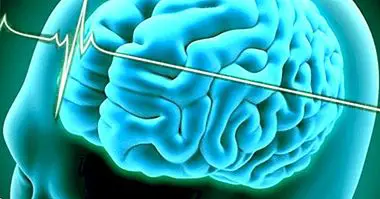Attention deficit without hyperactivity: symptoms and causes
Attention deficit hyperactivity disorder, commonly known by the abbreviation "ADHD", is characterized by two sets of different symptoms: those that are related to excess activity and behavioral impulsivity and those that are due to attention problems focused and sustained.
We speak of "attention deficit disorder without hyperactivity" in cases in which the symptoms of inattention clearly predominate over those of hyperactivity and impulsivity. In this article we will analyze the characteristics, symptoms and neuropsychological causes of attention deficit without hyperactivity .
- Related article: "Attention Deficit Hyperactivity Disorder (ADHD), also in adults"
Attention deficit disorder without hyperactivity
In the year 1980 the third edition of the Diagnostic and Statistical Manual of Mental Disorders appeared, commonly known as "DSM-III". In this version of the manual, the nomenclature "hyperkinetic reaction in childhood" was replaced by "attention deficit disorder", leaving hyperactivity in the background at the diagnostic level.
This change of perspective was mainly due to the investigations of the Canadian psychologist Virginia Douglas, whose results suggested that the nuclear clinical aspects of this disorder are the difficulties in paying sustained attention to stimuli , to inhibit impulses and for the organization of cognitive processes.
As a result, from the 1980s onwards, a distinction was made between two subtypes of attention deficit disorder: one in which the symptoms of hyperactivity predominate, equivalent to the classic form of the syndrome, and another in which this type of signs do not exist or they are less clinically relevant than inattention and / or behavioral impulsivity.
In the DSM-IV and in the 5, which has appeared very recently, two categories of symptoms are distinguished when describing attention deficit hyperactivity disorder: those of inattention, as the problems to organize tasks and the ease for distraction , and those of hyperactivity and impulsivity (excess of physical and verbal activity, interrupting others, etc.).
- Maybe you're interested: "The 16 most common mental disorders"
Main symptoms and clinical picture
Attention-deficit disorder without hyperactivity or predominantly inattentive are characterized mainly by the presence of symptoms derived from neurological problems that interfere with the mechanisms of brain inhibition. This makes it difficult for people with this disorder to maintain attention in a focused and sustained manner.
In this sense, the DSM-5 states that this variant of ADHD should be diagnosed when a child presents at least 6 of these symptoms markedly and persistently from before 12 years (in the case of adolescents and adults with 5 signs is sufficient):
- Neglect and lack of attention in academic, work and other tasks, especially in relation to the details.
- Difficulties to sustain attention in a sustained manner both in recreational activities and in others.
- Often the person gives the impression that he is not listening or that he is absent when spoken to.
- Failures to follow instructions that lead to the lack of completion of tasks, and that are not due to negativism or understanding problems.
- Problems to organize and plan activities, especially if they are sequential; It includes inadequate time management.
- Avoidance and lack of motivation and pleasure by tasks that require a significant mental effort and maintained .
- Frequent losses of important objects for the performance of certain activities.
- Facility for distraction due to external stimuli and mental contents not related to the current task.
- Frequent forgetfulness related to everyday activities , how to do homework, attend medical visits or pay bills.
In contrast, in these cases the symptoms and signs of hyperactivity and / or impulsivity are significantly milder than those associated with attention deficits. There is also a mixed type in which important symptoms of these two main dimensions are combined.
For decades, attention deficit disorder without hyperactivity has been linked to the slow cognitive tempo, characterized by hypoactivity, slowness, laziness and mental confusion . Nowadays it is known that it also appears in cases with hyperactive and impulsive predominance and in other psychological alterations, so it is not specific to this problem.
- Related article: "Slow Cognitive Tempo: causes and related disorders"
Causes and neuropsychological characteristics
According to the review of the available scientific evidence that Adele Diamond (2006) carried out, the main cognitive problem of people with attention deficit without hyperactivity is found in working or working memory. This set of processes allows us to store information in the short term and perform operations on it.
Diamond states that the signs that are detected in those who have this disorder are not so much due to their greater facility for distraction or for behavioral inhibition, which has been proposed frequently, as to the fact that get bored easily because of a chronic cerebral hypoactivity . This would explain his lack of motivation for many tasks.
At a biological-structural level, these problems seem to be related to the connections between the frontal and parietal cortex. While motor skills and executive functions, such as behavioral inhibition and planning, depend mainly on the frontal lobes of the brain, the parietals are concerned with symbolic and arithmetic processing, among other functions.
Diamond's meta-analysis suggests that the differences detected between predominantly inattentive and hyperactive / impulsive ADHD (in terms of neurological alterations, symptoms, psychopathological comorbidities and response to medication) may be sufficient to justify the division of this disorder into two differentiated syndromes .
Bibliographic references:
- American Psychiatric Association (2013). Diagnostic and Statistical Manual of Mental Disorders (5th Ed.). Arlington: American Psychiatric Publishing.
- Diamond, A. (2006). Attention-deficit disorder (attention-deficit / hyperactivity disorder without hyperactivity): A neurobiologically and behaviorally distinct disorder from attention-deficit / hyperactivity disorder (with hyperactivity). Development and Psychopathology, 17 (3): 807-825.



















